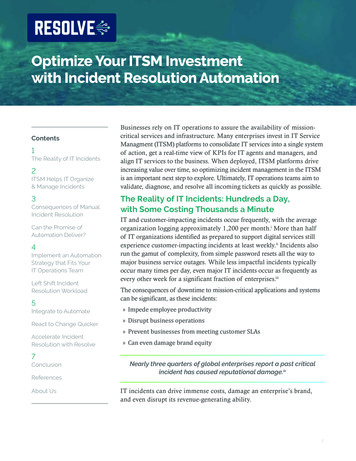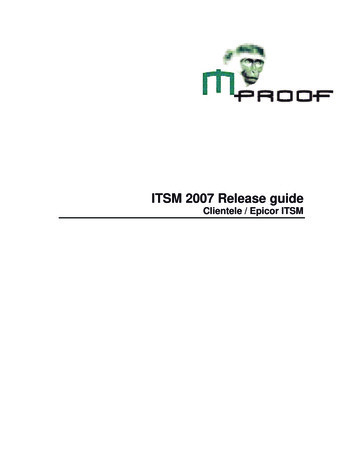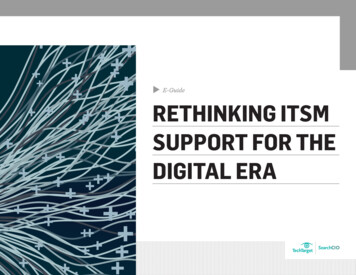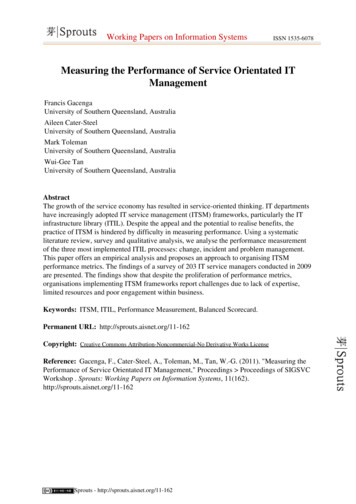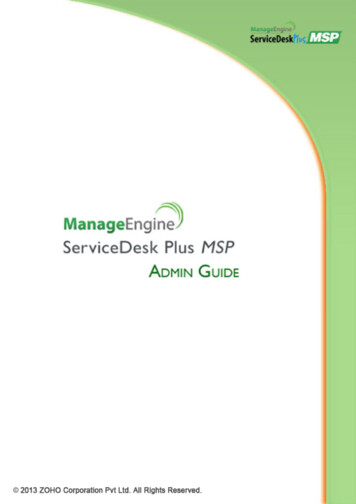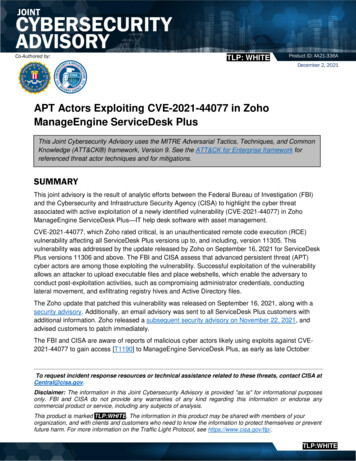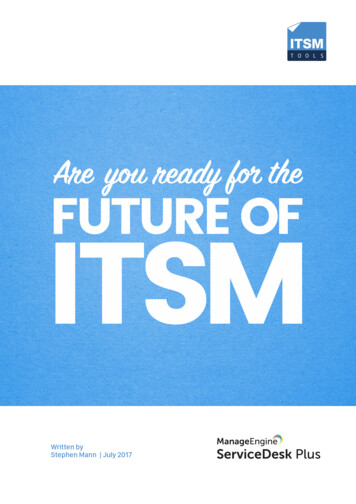
Transcription
What the future holds for corporate IT organizations and the people who work within them is anunknown. But, in the words of the man dubbed “the founder of modern management” Peter Drucker:“The best way to predict the future is to create it.”Thus, in Q2 2017, ITSM.tools ran a global IT service management (ITSM) Future readiness survey tobetter understand what ITSM professionals were thinking and doing – asking ten questions related tothe potential future challenges and opportunities that they and their companies face. These questionswere spread across five distinct areas:1.2.3.4.5.Working in ITThe impact of politics on IT staffingNew technologyBest practice, andMeeting service expectations.With the ambition to avoid the more usual ITSM survey questions such as the current and plannedlevel of ITIL process adoption or the inclination for ITSM tool replacement.The key survey findings, from 323 responses, include that: 82% of respondents believe that working in IT will get harder over the next three years, and onlyone in four respondents feel that their efforts and value are sufficiently recognized by management Nearly two-thirds of respondents think that the current local and global political climate isadversely affecting IT recruitment Just 16% of respondents view the adoption of artificial intelligence (AI) capabilities as a seriousjob killer in IT Only 24% of respondents think that existing ITSM best practice has kept up with the changing ITand business landscapes 70% of respondents think that there has been insufficient involvement of ITSM personnel in theircompany’s DevOps activities and ambitions 77% of respondents think that there is still more to be done to meet the expectations of Millennialemployees.Greater detail on each of these can be found in the main body of this report. Details on the survey’spromotion methods and respondents are included in the end notes.12
Working in ITWorking in IT can be a challenge no matter your role. Thecorporate mandate for IT departments to “do more withless” has been prevalent for at least a decade; with IT skillsshortages, increasing technology and business complexity,security issues, and other things all adding to the challenge.So, is “IT life” getting harder? And how are the peopleworking in IT recognized, and hopefully rewarded, for goingthe extra mile in their roles?To get answers to these questions, the first survey questionasked:“Do you think working incorporate IT will get harderover the next three years?This garnered the following responses:35.9%Yes, for all IT roles46.4%Yes, for some IT roles14.9%No2.8%Not sureWith a total of 82% of respondents believing that workingin IT will get harder over the next three years. Only 15%of survey respondents didn’t think that their life would getharder.As to why there’s a higher response for “Yes, for some ITroles” than “Yes, for all IT roles” – this might reflect that someIT roles are getting harder, or it might just be the very-humanassumption that “the grass is always greener on the other sideof the fence.” With respondents thinking that they are in aparticularly difficult role versus their peers.01
For instance, service desk agents are usually under far greaterscrutiny (and pressure) in terms of performance metrics andtargets than most other, if not all, IT roles. Whereas in someareas, such as the management of legacy IT systems, rolesmight be viewed as being under less pressure and less likelyto change.The second question then asked:“Do you feel your personalefforts, and your value to thebusiness, are sufficientlyrecognized by management?This garnered the following responses:26.2%Yes49.2%23.1%Sometimes,but not enoughNo1.6%Don’t knowOne quarter of respondents felt that their efforts and value aresufficiently recognized by management. Leaving two in fourpeople thinking that they do get recognized but not enough,and one in four thinking that they don’t get recognized fortheir work; giving a total of 75% respondents who feelundervalued. This compares unfavorably with a recent USsurvey that showed 47% of workers feel underappreciated.02
The Impact ofPolitics onIT StaffingImmigration policies are increasingly playing a key rolein political policies, and voting, globally. Examples of thisinclude: The Australian government’s restrictions on which jobscan be filled by foreign workers The UK vote to leave the European Union, and The Republican victory in the US.Hence, the survey posed two questions related to thepotential effects that immigration barriers would have on ITrecruitment. The questions were also posed in a manner suchthat the respondent could answer either on a personal level, asa job seeker, or alternatively as a recruiter of people.The first staffing question asked:“Do you think the currentlocal, and global, politicalclimate is adversely affectingIT recruitment?This garnered the following responses:20.6%Yes, for all roles42.5%Yes, for some roles27.8%No9.1%Don’t knowNearly two-thirds of respondents thought that the currentlocal and global political climate is adversely affecting ITrecruitment – with some roles seen as more affected thanothers.03
The question was intended to understand the potentialdifficulties currently faced by people wanting to work in, orrecruit from, other countries; but it’s appreciated that it couldalso include responses related to the effect of governmentfiscal policies dampening economic growth and consequentlythe recruitment of new staff.The follow-up staffing question asked:“Do you think the changingpolitical climate will makethe future recruitment of keyIT staff difficult?This garnered the following responses:22.6%Yes, globally40.3%Yes, only in some geographies27.0%No10.1%Don’t knowThe above breakdown shows that the future recruitment ofIT staff is more likely to be limited to certain geographiesthan a globally-impacting issue. But with nearly two-thirds ofrespondents expecting current and future political decisionsto adversely affect the recruitment of key IT staff in at leastsome geographies, it’s definitely an area in which corporateIT organizations need to plan for a change to the status quo.04
NewTechnologyThere’s no denying that corporate IT is undergoing what hasto be the most consistently-turbulent period of technologychange, coupled with changing business expectations of ITservices, service delivery, and support. Cloud has played,and continues to play, a big part in that change – potentiallymaking it easier for organizations to buy/create, manage, andchange business applications as needed.The cloud technology is in some ways now taken for granted.Many of the early cloud issues – related to security and serviceavailability – have now been replaced by those related topeople, skills, and cloud management capabilities. And thosewho consume IT services aren’t concerned about where theiremail is delivered from, their files are stored, or their music isstreamed from. The cloud technology just works, and workswell – that is until there’s a high-profile cloud failure.The timeliness of one particular high-profile cloud failure tothis survey – which affected a number of popular consumer,as well as corporate, cloud services – was the basis for thesurvey’s fifth question, which asked:“To your knowledge, did theFebruary 2017 AWS S3failure negatively affect yourcompany’s position on cloud?This garnered the following responses:8.4%Yes24.0%Maybe, it got usthinking about risks47.4%No20.2%Don’t know/not aware05
The survey responses were affirmation that people stronglybelieve in the benefits of public cloud services despite anyhigh-profile failures reported in the media – only 8% ofrespondents felt that the Amazon failure had adverselyaffected their company’s position on cloud. And while 24% ofrespondents stated that it got them “thinking about risks,” thisis a positive thing, and a timely reminder of who is ultimatelyresponsible for IT service availability in cloud service models– the customer.“Do you believe the use ofartificial intelligence willreduce IT staff numbersbetween now and 2020?This garnered the following responses:15.5%Yes, considerably44.1%Yes, but notdramatically32.3%No5.6%Don’t know2.5%What’s artificialintelligence?So, in the main, the survey respondents don’t see AI as a majorthreat to IT jobs – with only 15% of respondents viewing theadoption of the new capabilities as a serious job killer. In manyways, AI can be seen as the next evolution of automation,following data center automation, ITSM-process workflowautomation, and orchestration. Adding “heavy thinking,”especially through machine learning, to the existing “heavylifting” benefits of more traditional automation.06
ITSMBest PracticeThe evolution of ITSM best practice is an interesting areato investigate, with it subject to the pressures of both thechanging IT and business landscapes plus the introduction ofnew, or increasingly popular, approaches to IT managementand service delivery that include DevOps (including Leanand Agile), service integration and management (SIAM),business relationship management (BRM), enterprise servicemanagement, and IT4IT among others.One could also argue that the impact of the growing adoptionof cloud services on ITSM has been seen through twodifferent, and opposed, lenses – with one school of thoughtbeing that ITSM is less relevant with cloud, and the otherbeing that service management capabilities are now evenmore important. After all, cloud offers services that need tobe managed.The first best-practice focused question asked:“In your opinion, do youbelieve ITIL, and other ITSMbest practice, have kept upwith the changing businessand technology landscapes?This garnered the following responses:24.3%Yes52.3%In parts, but not enough14.6%No, we need acomplete refresh5.3%No, but I’m not bothered3.4%Don’t know07
Perhaps the most interesting results are that: Only 5% of respondents aren’t bothered if ITSM bestpractice has become outdated. It’s testament to theindustry’s ongoing interest and reliance on the sharing ofthings that will help to improve operational performanceand IT service delivery. 14% of respondents believe that a complete refresh isneeded. This could, of course, mean multiple things.For instance, that not enough has changed to warrant acomplete refresh. Or, alternatively, that a single body ofITSM best practice knowledge is going to be too difficultto deliver and maintain; and perhaps, because of theincreasing rate of change, that a complete refresh couldalready be out of date by the time it’s published.There’s a need to do something though, as only 24% ofrespondents think that existing ITSM best practice has keptup with the changes happening around it. If you still thinkthat this is high, then please remember that different people,in different organizations, have different needs.For example, if an organization only needs to use ITSM bestpractice related to the IT service desk – incident managementand service request fulfilment, say – then they’re more likelyto think that the currently-available best practice is sufficientthan a different organization that is looking to understandhow best to meet capacity management needs in a hybridcloud environment, say.The second best-practice question asked:“How involved have ITSMpersonnel been in yourcompany’s DevOps activitiesand ambitions?08
This garnered the following responses:12.5%Fully39.7%Partially, but it’sinsufficientNo, or close to no,involvementDon’t know/notapplicable30.6%17.2%There’s no escaping the growing popularity of DevOps,with the 2017 annual Puppet State of DevOps Report againhighlighting almost unbelievable performance improvementsfor those organizations that are getting DevOps right. Thisincludes that: “High performers have: 46 times more frequent codedeployments; 440 times faster lead time from committo deploy; 96 times faster mean time to recover fromdowntime; and 5 times lower change failure rate (changesare 1/5 as likely to fail).” “High-performing organizations spend 21 percent lesstime on unplanned work and rework, and 44 percent moretime on new work.”But as DevOps is about Development and IT Operations, andITSM is part of the latter, it’s disappointing – although notunexpected – to see that only 13% of respondents feel thatITSM personnel have been fully involved in their company’sDevOps activities and ambitions. With 70% of respondentsstating that there has been insufficient or no involvement.09
MeetingServiceExpectationsWhile the thing that the IT industry called the “consumerizationof IT” shook up many, if not all, corporate IT organizations interms of what corporate IT devices, apps, and cloud servicesshould be like. The industry overlooked that consumerizationis about so much more than just the IT. That, instead,consumerization is a far-wider-reaching phenomenonthrough which employee expectations of corporate services,service delivery, customer support, and customer experienceare being influenced by their consumer-world experiences.The bottom line is that, as employees receive better servicesand support in their personal lives, they expect also morefrom corporate service providers such as IT, human resources(HR), and facilities.The first service-expectations question asked:“How do you think your ITdepartment is meetingemployee expectations –across services, support, andcustomer service – versusconsumer-world companies?This garnered the following responses:29.2%Better28.0%The same40.7%Behind2.2%Don’t know10
Interestingly, and surprisingly, 29% of respondents thinkthat their IT department delivers better services, support,and customer service to employees than could be expectedfrom consumer-world companies. This could, of course,be the case – that the companies the respondents work fordeliver exemplar IT services and support. However, it couldalso be an indication of the continued disconnect between ITemployee perceptions of the services they provide and thegrowing expectations of employees – “the expectations gap.”Perhaps more expected is that 28% of respondents think thattheir companies offer a similar level of services, support,and customer service to consumer-world companies, withthe highest score (40%) attributed to IT departments beingbehind the consumer-world.The survey’s tenth and final question asked:“Is your IT department readyto meet the expectations ofthe growing number ofMillennial employees?This garnered the following responses:14.6%Yes, in all areas48.1%Yes, in some areas butnot enough28.9%No8.4%Don’t knowIn many ways, this is also an indication of IT departmentreadiness for consumerization, as the enhanced needsof Millennials have been built on their consumer-worldexperiences of technology and their access to information andservices.11
However, in conflict with the previous question, only 15% ofrespondents think that their IT department’s capabilities arefully suited to the wants and needs of Millennials – with 77%of respondents thinking that there is still more to be done.This conflict raises a query as to why there’s such adiscrepancy, with possible causes being that respondents, andtheir companies: Underestimate the impact that consumerization is having,and will continue to have, on employee expectations ofcorporate IT – as a massive 57% of respondents thinkthat their IT department currently matches or exceeds theefforts and capabilities of consumer-world companies. Rate the wants and needs of Millennials higher thanthe needs of older employees who have also had theirexpectations raised significantly by their personal-lifeexperiences of services, customer service, and support.Either way, it requires IT departments to better understand theneeds of all end users and how well existing capabilities aremeeting those needs.ConclusionHopefully this paper, and the survey it’s built on, has youthinking about many of the key challenges, plus of course theopportunities, that ITSM professionals are currently facingand will continue to face over the next three years.Whether these challenges relate to the difficulties of workingin IT, recruitment, the impact of new technologies, usingbest practices to better meet growing service expectations, orsomething else – we achieve more as an “ITSM community”when our concerns, issues, and solutions are shared.So, use the information provided by ITSM and IT supportmembership organizations, ITSM services and tool providers,or ITSM content distributers to not only stay informed, but toalso receive advice on how best to be ready for the futureneeds of service management. Change is hard but don’t makeit even harder by failing to tap into publicly available helpand advice.12
The ITSM Future Readiness Survey was shared via social media (Twitter, Facebook, and LinkedIn), the monthly ITSM.tools newsletter, and the surveysponsors – ManageEngine – emailed it to a selection of its customers. While the survey was anonymous, it’s assumed that most of the 323 respondentsare ITSM professionals given the way in which it was eel-under-appreciated2017 Puppet State of DevOps Report: evops-report13
Thus, in Q2 2017, ITSM.tools ran a global IT service management (ITSM) Future readiness survey to better understand what ITSM professionals were thinking and doing - asking ten questions related to the potential future challenges and opportunities that they and their companies face. These questions were spread across five distinct areas: 1.


